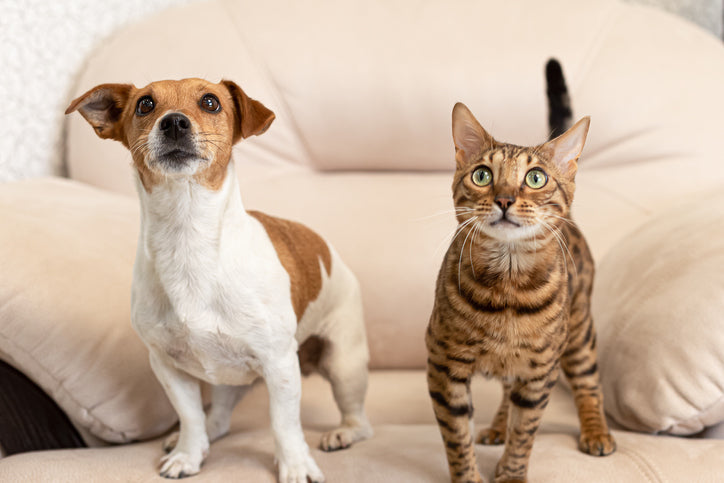
Where To Start If Your Cat Needs To Lose Weight
The first place to start is confirming if your cat is overweight, so you can then make a plan and track your progress.
Weighing your cat is helpful, as is using a body condition chart, like the one below.
If you find this difficult to work out, which can be the case for especially fluffy breeds, your vet can also advise if your cat needs to lose weight and how much.
Sometimes unexplained weight gain can be caused by an underlying health issue, so it’s important to have a thorough check up at the vet before making any major lifestyle or diet changes.

Unfortunately, not all vets are well educated on the topic of fresh food diets, and some aren’t supportive of this style of feeding.
This is a complex topic that relates to both the risks of poorly formulated homemade recipes, and the influence of the billion-dollar pet food industry.
The recipes in this guide have been formulated to meet the AAFCO standards for cats, which is the same standards commercial pet food in Australia aligns with. This will hopefully encourage your vet to support your endeavour, but if not finding a vet that supports fresh foods is a helpful step to successfully implementing this meal plan.
A supportive vet can encourage and guide you, building your confidence and supporting you both on this journey to wellness.
Why switch to fresh foods?
If you’ve ever embarked on a plan to eat healthier and lose weight yourself, you’ve no doubt been told you should eat as much fresh, unprocessed food as possible, and avoid things like refined sugars, unhealthy fats, and heavily processed carbs.
You would think this approach would also apply to our animals, but a cursory glance at the weight loss section of your local pet food store reveals even more heavily processed foods that are carbohydrate based and bear no resemblance to anything that could be considered fresh or whole.
Typically, they achieve their lower calorie density with the addition of large amounts of indigestible fibre, which can actually interfere with nutrient absorption, rather than encourage it.

Their refined flour foundation is likely to cause insulin to spike, which may ultimately lead to weight gain. These foods leave your cat feeling hungrier than ever and poorly nourished, while rarely actually leading to any major weight loss – and certainly not healthy weight loss.
A far superior way to support your cat to reach a healthier weight is to provide them with nutrient dense and highly digestible food that suits their digestive and metabolic needs. This will not just help them lose weight, but also improve their overall health and wellbeing.
Fresh foods contain highly bioavailable nutrients – as opposed to the synthetic nutrients in most pet foods – as well as digestive enzymes, pre and probiotics and antioxidants.
These compounds support the health of the gut, where around 70% of the immune cells live, they fight oxidative stress and inflammation, which can help to ward off disease, and they work with the body, not against it, making your pet more comfortable and energetic.
Fresh foods also contain a lot of water, which is a critically important factor in your cat’s health. Cats are desert creatures that are evolutionarily predisposed to obtain their water from food.
Modern day pet food often contains no water at all, leaving our cats in a perpetual state of dehydration, stressing the organs, and leading to a plethora of health issues, particularly around the kidneys and urinary tract.
Water is the most important nutrient any of us consume and a fresh diet will naturally keep your cat hydrated, which will help with their weight loss, but also their overall health and the health of their organs.
What is a species appropriate diet?
A species appropriate diet is one that is well suited to the metabolic capabilities of your cat’s digestive system.
Even the most diehard processed pet food advocate will acknowledge that cats are obligate carnivores designed to eat a prey-based diet; this is simply an undisputable fact that has not changed as a product of domestication.
While dogs do produce some of the digestive enzyme amylase in their pancreas, which is necessary for the digestion of starches, cats produce only 5% as much amylase as dogs, making the task of digesting carbohydrates even more difficult for them.
They have several other biological markers that point to their truly carnivorous nature, such as their innate need for taurine.
Taurine is an amino acid only found in animal protein. While other animals, such as humans and dogs, can convert taurine from the amino acids methionine and cysteine – which are found in plant foods – cats cannot.
Similarly, dogs, humans and other creatures that sit on the scale of omnivorousness can biosynthesise vitamin A by converting it from beta carotene in their liver, whereas cats cannot and must obtain true vitamin A from dietary sources (such as liver).
Cats are unable to synthesise vitamin D from sunlight or convert the plant based D2 to the essential D3, meaning it too must be supplied in the diet from animal protein sources.
They have higher requirements for B vitamins, especially niacin, and they are so efficient at digesting protein that a single meal without arginine could kill them (which admittedly is very unlikely). Arginine is an amino acid that cats do not possess the capacity to synthesise, but which is essential to remove the ammonia that is produced during protein digestion.
Fortunately, animal protein is high in arginine, so it’s generally a problem that solves itself when a species appropriate diet is fed. Isn’t nature grand?
What does a species appropriate diet really look like?
Given that cats are true carnivores, in nature they would hunt small animals like rodents and birds to fulfill their nutritional needs.
Fortunately, we can replicate this using the recipes in this meal plan and raw ingredients that you can buy at the supermarket, butcher or health food store. We’ve chosen a variety of lean proteins, healthy fats, and fibre, as well as herbs and superfoods to fill nutritional gaps and add functional nutrition benefits.
Some of the recipes have a small amount of digestible cooked vegetables (less than 10%), as they provide antioxidants, enzymes and fibre. Some cats won’t eat plant matter in fresh form, so you can just omit it if that’s the case for you.
These recipes are fairly low calorie, but this style of feeding our pets is often inherently a weight management diet and will naturally result in fat loss and lean muscle gain, without needing to drastically restrict portions.
These foods are well suited to your cat’s digestive system so are easily digested with highly bioavailable, organic nutrients, leaving your cat feeling satisfied. Most cats love fresh foods too (and we’ve included plenty of tips if they don’t love it immediately!)
- FAQ's on raw feeding
- FAQ's on Healthy Active Pet
- What is in commercial pet food
- Why good nutrition is important
Check out our 4 week cat challenge that will put your cat on the right track

